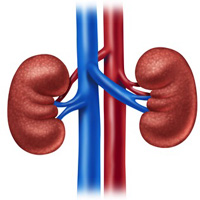Mini percutaneous nephrolithotomy versus retrograde flexible ureterorenoscopy in the treatment of renal calculi in anomalous kidneys

Accepted: April 21, 2021
All claims expressed in this article are solely those of the authors and do not necessarily represent those of their affiliated organizations, or those of the publisher, the editors and the reviewers. Any product that may be evaluated in this article or claim that may be made by its manufacturer is not guaranteed or endorsed by the publisher.
Objectives: To report our single center experience in comparing mini-percutaneous nephrolithotomy versus flexible ureterorenoscopy for management of renal stones up to 2 cm in anomalous kidneys.
Materials and methods: Records of the last 30 patients with stones less than 2 cm in anomalous kidney treated by mini-percutaneous nephrolithotomy were reviewed and compared to last 30 patients treated by flexible ureterorenoscopy.
Results: Mean stone size was significantly higher in the minipercutaneous nephrolithotomy group (17.90 mm) than in flexible ureterorenoscopy group (14.97mm) (p < 0.001). Mean operative time (80.33 min vs 56.43 min) and fluoroscopy exposure time (4.49 min vs 0.84 min) were significantly higher in the mini-percutaneous nephrolithotomy group than in the flexible ureterorenoscopy group (p < 0.001). The mean post-operative drop in hemoglobin concentration was significantly higher in the mini-percutaneous nephrolithotomy group (0.47 gm versus 0.2 gm) (p < 0.001). Stone free rate after 12 weeks follow up was not statistically significant between the 2 groups (90% in minipercutaneous nephrolithotomy vs 80% in flexible ureterorenoscopy) (FEp = 0.472).
Conclusions: Both modalities were found to be safe and effective for treatment of stones less than 2 cm in anomalous kidneys.
Yosypiv IV. Congenital anomalies of the kidney and urinary tract: a genetic disorder? Int J Nephrol. 2012; 2012:909083. DOI: https://doi.org/10.1155/2012/909083
Weizer AZ, Springhart WP, Ekeruo WO, et al. Ureteroscopic management of renal calculi in anomalous kidneys. Urology 2005; 65:265-9. DOI: https://doi.org/10.1016/j.urology.2004.09.055
Gupta M, Lee MW. Treatment of stones associated with complex or anomalous renal anatomy. Urol Clin North Am 2007; 34:431-41. DOI: https://doi.org/10.1016/j.ucl.2007.04.004
Desai M. Ultrasonography-guided punctures-with and without puncture guide. J Endourol 2009; 23:1641-3. DOI: https://doi.org/10.1089/end.2009.1530
Graham B. Generic health instruments, visual analog scale, and the measurement of clinical phenomena. J Rheumatol 1999; 26:22-3.
Gupta NP, Mishra S, Seth A, et al. Percutaneous nephrolithotomy in abnormal kidneys: single-center experience. Urology 2009; 73:710-4. DOI: https://doi.org/10.1016/j.urology.2008.10.070
Osther PJ, Razvi H, Liatsikos E, et al. Percutaneous nephrolithotomy among patients with renal anomalies: patient characteristics and outcomes; a subgroup analysis of the clinical research office of the endourological society global percutaneous nephrolithotomy study. J Endourol 2011; 25:1627-32. DOI: https://doi.org/10.1089/end.2011.0146
Mosavi-Bahar SH, Amirzargar MA, Rahnavardi M, et al. Percutaneous nephrolithotomy in patients with kidney malformations. J Endourol 2007; 21:520-4. DOI: https://doi.org/10.1089/end.2006.0349
Rana AM, Bhojwani JP. Percutaneous nephrolithotomy in renal anomalies of fusion, ectopia, rotation, hypoplasia, and pelvicalyceal aberration: uniformity in heterogeneity. J Endourol 2009; 23:609-14. DOI: https://doi.org/10.1089/end.2007.0430
Khadgi S, Shretha B, Ibrahim H, et al. Mini-percutaneous nephrolithotomy for stones in anomalies-kidneys: a prospective study. Urolithiasis 2017; 45:407-14. DOI: https://doi.org/10.1007/s00240-016-0926-1
Molimard B, Al-Qahtani S, Lakmichi A, et al. Flexible ureterorenoscopy with holmium laser in horseshoe kidneys. Urology 2010; 76:1334-7. DOI: https://doi.org/10.1016/j.urology.2010.02.072
Gajednra A, Singh J, Sabnis R, et al. Role of flexible uretrorenoscopy in management of renal calculi in anomalies kidneys: single-center experience. World J Urol 2017; 35:319-24. DOI: https://doi.org/10.1007/s00345-016-1881-8
Di Mauro D, La Rosa VL, Cimino S, Di Grazia E. Clinical and psychological outcomes of patients undergoing Retrograde Intrarenal Surgery and Miniaturised Percutaneous Nephrolithotomy for kidney stones. A preliminary study. Arch Ital Urol Androl. 2020; 91:256-260. DOI: https://doi.org/10.4081/aiua.2019.4.256
Binbay M, Istanbulluoglu O, Sofikerim M, et al. Effect of simple malrotation on percutaneous nephrolithotomy: a matched pair multicenter analysis. J Urol 2011; 185:1737-41. DOI: https://doi.org/10.1016/j.juro.2010.12.060
Shokeir AA, El-Nahas AR, Shoma AM, et al. Percutaneous nephrolithotomy in treatment of large stones within horseshoe kidneys. Urology 2004; 64:426-9. DOI: https://doi.org/10.1016/j.urology.2004.04.018
Viola D, Anagnostou T, Thompson TJ, et al. Sixteen years of experience with stone management in horseshoe kidneys Urol Int 2007; 78:214-8. DOI: https://doi.org/10.1159/000099340
Ozden E, Bilen CY, Mercimek MN, et al. Horseshoe kidney does it really have any negative impact on surgical outcomes of percutaneous nephrolithotomy? Urology 2010; 75:1049-52. DOI: https://doi.org/10.1016/j.urology.2009.08.054
Raj GV, Auge BK, Weizer AZ, et al. Percutaneous management of calculi within horse-shoe kidneys. J Urol 2003; 170:48-51. DOI: https://doi.org/10.1097/01.ju.0000067620.60404.2d
Haddad R, Freschi G, Figueiredo F, et al. Flexible ureterorenoscopy in position or fusion anomaly: is it feasible? Rev Assoc MED BRAS 2017; 63:685-8. DOI: https://doi.org/10.1590/1806-9282.63.08.685
Eryildirim B, Kucuk EV, Atis G, et al. Safety and efficacy of PNL vs RIRS in the management of stones located in horseshoe kidneys: A critical comparative evaluation. Arch Ital Urol Androl. 2018; 90:149-154. DOI: https://doi.org/10.4081/aiua.2018.3.149
PAGEPress has chosen to apply the Creative Commons Attribution NonCommercial 4.0 International License (CC BY-NC 4.0) to all manuscripts to be published.


 https://doi.org/10.4081/aiua.2021.2.167
https://doi.org/10.4081/aiua.2021.2.167



